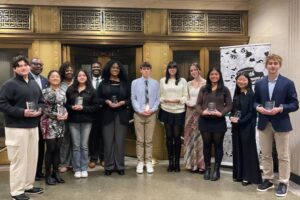
Drawing upon their knowledge of chemistry and heat exchange, Irvington High School students in teacher David Whitehead’s Chemistry Honors classes recently conducted a laboratory investigation. While working in groups, they learned how to communicate, design and engineer a solution to a real-world problem.
As part of their studies, the students have been exploring the Thermochemistry chapter, which focuses on heat, phase change, energy transformations and the associated calculations.
“The lab investigation was designed to study heat exchange and heat of combustion using a simple calorimeter,” Whitehead said. “The students used science and engineering practices to design a solution to increase the amount of heat absorbed by the calorimeter and reduce loss to the surroundings.”
During the first part of the laboratory investigation, the students collected data, using a soda can calorimeter filled with water, which was designed to absorb the heat energy emitted by a burning candle. Taking into account the loss of wax used in combustion and the temperature increase of the water in the calorimeter, the students calculated the heat of combustion for their experiment. They concluded that there was significant heat loss due to the design and placement of the calorimeter and candle in relation to the rest of the room and surroundings.
During the second part of the investigation, the students were tasked with engineering and making alterations to their designs to increase the amount of heat absorbed by the calorimeter and cut the percent error in half. For their new designs, they were challenged to find new materials at home, incorporate them into their designs and turn their concepts into reality in a short period of time.
“The most important takeaway is that science doesn’t happen in a vacuum,” Whitehead said. “There are real-world problems that are out there, based on concepts that students are currently learning, that need design fixes. It allows for the students to flex their science muscles and offer a solution to authentic real-world problems.”
Whitehead said that his students took the investigation seriously and each group wanted to strive for the best result possible.







